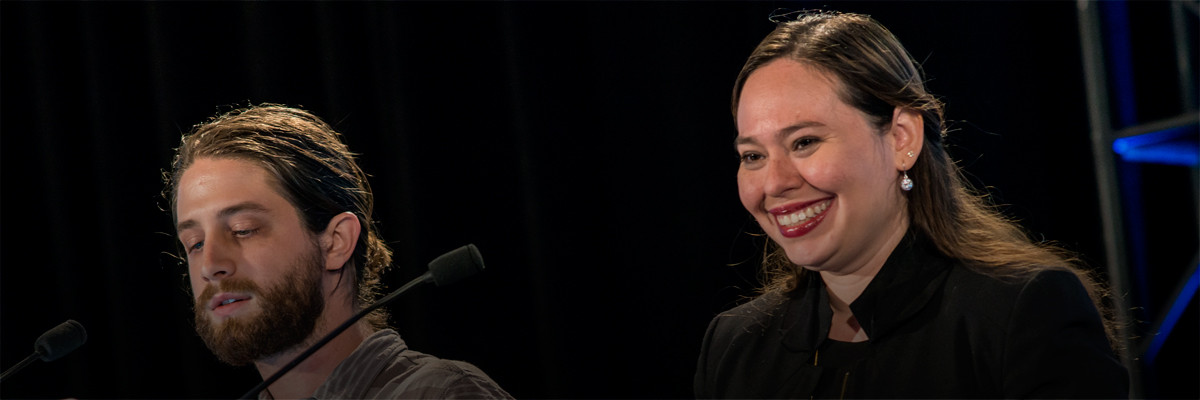
Last year's BSR Sustainability Hackathon winners RISE present at the BSR Conference 2014. Photo by Vincent Breton/BSR.
Authors
It’s that time of year again! Yes, back-to-school season is upon us, but I’m referring to the sustainability hackathon season.
For the past two autumns, Qualcomm has sponsored the BSR Sustainability Hackathon. We’ve seen some really great projects come out of it—and we have loved seeing in particular how many fabulous female engineers and innovators have gotten involved in hacking for a better world.
Want to be our next hackathon rock star? This year’s virtual hackathon will run from September 17-October 17, with in-person kick-off receptions in San Diego, San Francisco, and New York on the evening of September 17. The theme is transformative technology, and the main topic areas are economic development, inclusive economy, smart cities, efficient transportation, and cost-efficient healthcare. You can register for the Sustainability Hackathon to participate from anywhere around the globe.
I recently caught up with Anna Schneider, from the 2013 hackathon’s winning team, WattTime Windshed, to find out what the team has been up to in the past 22 months. Her team’s hack identified opportunities to increase wind power in the Northeastern United States. It turns out they’ve been busy.
In July 2014, Schneider and Gavin McCormick received the Echoing Green Climate Fellowship, which targets next-generation social entrepreneurs working on innovations to address and prevent climate change, to begin working on WattTime full time.
“Winning the BSR Hackathon was really crucial for us because it was a few weeks before I finished my Ph.D. in Biophysics,” Schneider said. “It really was a turning point because it gave us the vote of confidence that WattTime had real potential, real support.”
“Now we are an independent nonprofit with a mission to spread our technology to help people and companies save carbon and fight climate change by using electricity at the right time, when it is coming from the cleanest sources.”
Schneider made the Forbes 30 under 30 in Energy list in January of this year; then in June, WattTime released its first product in collaboration with eMotorWerks: the Juice Box Green 40, a smart electric-vehicle charging station capable of automatically reducing the carbon footprint of electric-vehicle charging through groundbreaking, environmentally smart timing algorithms.
WattTime’s vision? “For this technology to be built into all the different things and smart devices that are proliferating—that these smart ‘Internet of Things’ devices will automatically run at the time when they can use the cleanest power available,” says Schneider.
She and McCormick aren’t the only winning team members still hard at work. Last year’s winners, whose project was called Real-Time Industrial Symbiosis Exchange (RISE) are also still actively working on their hack.
Bertha Teresa Jimenez, a Ph.D. student at New York University Polytechnic School of Engineering and the group’s representative, told me the hackathon “was a great opportunity to get validation and feedback on our concept from people from various industries, and we realized that the idea really had potential. It was a good way to try to articulate our concept into a platform.” She added: “More than funding (which has helped us with further development), we earned recognition, a new set of skills, and a prototype to show. We are super motivated to take RISE to the next step,” Jimenez said, alluding that the team would have further updates in the coming months.
If you’re interested in joining the ranks of these esteemed innovators, you can register here for this year’s contest. Participating teams will upload videos explaining their projects, then select finalists will be invited to present their work to a panel of judges and BSR Conference attendees for voting.
The grand prize is US$5,000 and transportation and accommodation for up to two team members in San Francisco to present at the BSR Conference 2015. The winning team will present before more than 1,000 sustainability professionals on the morning of Thursday November 5.
San Diego locals can sign up here to attend the kick-off at Qualcomm headquarters, hosted at the Qualcomm Thinkabit Lab, a space that is the combination of a lab, maker space, and classroom for 6-8th grade students from all cultural and socioeconomic backgrounds, exposing and engaging them in science, technology, engineering, and math (STEM) or STEAM (+arts) activities in a fun way. The Lab is one of many ways we at Qualcomm are working to build a more diverse STEM pipeline. New York locals can join us at the Hatchery, and San Francisco-based hackers can join us at ImpactHub this Thursday as well.
Before you start brainstorming, a piece of advice from Schneider: “Do your research—think about what people have already done in the space. There are many ideas that people have already tried; take those ideas and use them as a springboard.”
Happy hacking! Oh, and you may want to be prepared to skip your 8 a.m. class this November.
This article first appeared on Qualcomm and is reprinted with permission.
Let’s talk about how BSR can help you to transform your business and achieve your sustainability goals.